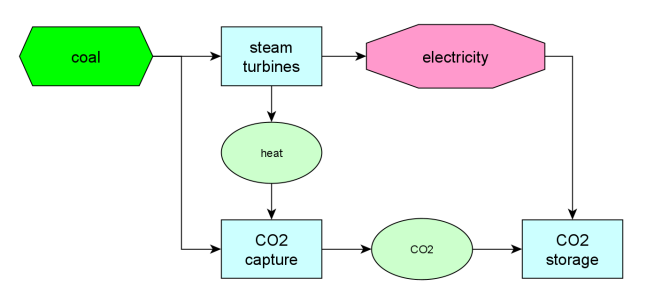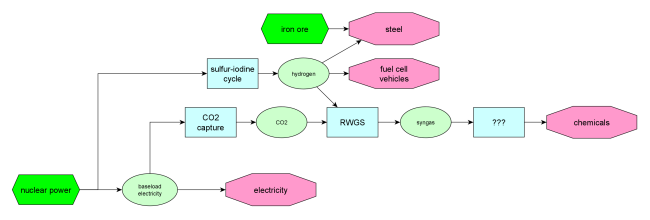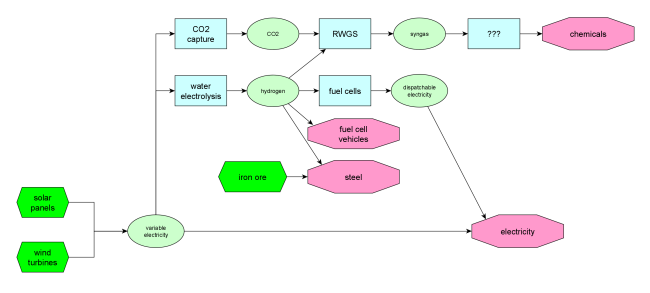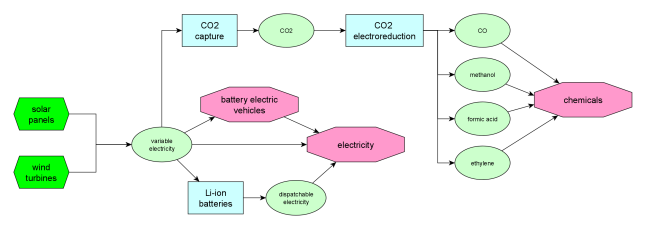=chemistry =energy =economics
This is an overview of some proposed futures of the foundational parts of the economy, those related to energy and material production.
the current system
First, here's a flowchart for the
current US economy. (Yes, obviously this is very high-level and simplified.)
Why does this need to be changed? What are some
problems to try to solve?
Reduction of CO2 emissions is desired. The
easiest way to do that is to reduce coal usage by replacing coal power with
(natural gas + solar + wind) and that's already been happening in the USA
because it's cheaper than coal plants. Companies are also starting to
replace coal with natural gas for steel production. However, the USA now
only makes ~6% of the world's steel, and natural gas is more expensive in
most other places.
Sources of crude oil are limited, more so than
coal or natural gas. Oil is now significantly more expensive than other
sources of energy.
Piston-engine vehicles produce large amounts of
particulate pollution. Alternative fuels could reduce that pollution
greatly.
Trees take a while to grow, and lumber is usually more
expensive than in the USA. Engineered wood products mostly use
urea-formaldehyde resin, which can release (toxic) formaldehyde.
Concrete tends to crack over time, gets dirty when outside, and usually has
poor mechanical properties.
Current thermoplastics are either
expensive or have poor performance in some ways, such as strength, heat
resistance, UV resistance, hydrolysis resistance, etc. Current composites
are expensive. Many plastics contain toxic additives such as phthalates and
PBDEs. Biodegradable plastics are expensive and/or have poor performance.
Many plastics contain things that can't be easily incinerated.
So, let's look at some proposed alternatives.
cellulosic ethanol
First,
cellulosic ethanol.
Normally ethanol is made by fermenting sugar or starch, but cellulose is
much cheaper. So, the US government has spent large amounts of money
researching this at places such as Idaho National Laboratory.
Some microbes can
digest cellulose, so why not just get some and engineer them to make
ethanol? Unfortunately, even small amounts of ethanol disrupt the
cellulose-degrading enzymes. This problem can't be solved and this approach
has now been abandoned.
Sulfuric acid can hydrolyze cellulose
into soluble sugars. Unfortunately, this also produces toxic compounds that
inhibit fermentation, and the required processing is expensive. I estimate
ethanol with this approach would be ~$8.5 per gallon of gasoline equivalent,
not including transportation or taxes, and I don't believe it can be cheaper
than fermenting sugar.
With gasoline prices above $5/gallon in the
USA in 2022, that might not sound so bad, but those high prices mostly come
from refiners making enormous profits because refining capacity is the
bottleneck.
Alternatively, cellulose-degrading enzymes could be produced and used to process cellulose for fermentation. However, microbes use a large fraction of the energy they get from cellulose to produce those enzymes, and cellulose degradation involves a complex combination of multiple microbes and enzymes that lose effectiveness if you try to isolate them. This ends up being more expensive than sulfuric acid, and I don't believe it can be cheaper than fermenting sugar.
burning biomass
It's possible to burn biomass in
boilers instead of coal. There can be issues with ash melting and
accumulating on things, but this works well enough and has been used on a
large scale.
Biomass is perhaps 2x as expensive per joule as coal,
but the CO2 avoidance cost of using biomass instead of coal is quite low,
~$30/ton. There are 2 problems:
- in many
places, coal power isn't competitive, so the net cost is higher
- land
requirements
If you consider China, almost its
entire land area would be required to replace all its coal usage with
switchgrass.
I mention switchgrass because it's been the main focus
of US government research into biomass-based energy, but there are other
things that produce much more per hectare. The problem is that the plants
that give the most dry tons of biomass per hectare, such as "energy cane",
also require more fertilizer and water per ton. The supply of phosphate
fertilizer is also a long-term problem that exists.
clean coal
Then, there's "clean coal" - coal
power with CO2 capture and sequestration, perhaps underground at high
pressure. Coal produces flue gas with lots of CO2, and you can get heat
suitable for amine stripping of CO2 from that at the cost of some
efficiency, but capturing and storing CO2 is expensive and uses a large % of
the power from coal. Coal power is already too expensive without adding more
costs to it, and this would more than double the cost of it. The only reason
to do this is if you need large amounts of pure CO2, more than can be
captured from ammonia production and fermentation.
The US spent $7
billion on the Kemper
Project alone, which was cancelled without ever running.
nuclear power
Another proposed future was a
nuclear one: electricity all coming from nuclear plants, and
high-temperature nuclear plants producing hydrogen fuel.
The main
problem is just that nuclear power plants are too expensive. The problem
wasn't really that nuclear got more expensive; it was that other stuff got
cheaper. Gas turbines were more like cars, and nuclear power plants were
more like houses, and construction of new houses got more expensive because
of...inflation, mostly. (If you look at the cost of construction vs
services over time,
the lines are pretty similar.)
And now, people have actually forgotten how to make them.
If you set aside geopolitical issues, coal is now generally more expensive than
natural gas. Nuclear power plants
are similar to coal plants
with a more expensive heat source, so they're more expensive than coal,
which is why China is still mostly going for coal over nuclear; their
nuclear plants only happened because China wanted a lot more nuclear weapons
and also thought some experimentation was worthwhile. Similarly, France made
lots of nuclear power plants because the government wanted lots of nuclear
weapons, not because they were actually cheap.
There's also the
problem of there not being enough nuclear fuel to run the whole world on
current nuclear reactors very long. The proposed solution was breeder
reactors, but those are less safe and even more expensive. Some people want
to get uranium from seawater, but they're delusional or can't do math:
processing seawater costs more than the electricity from uranium in it is
worth.
Nuclear hydrogen proposals were usually based on the
sulfur-iodine
cycle, but that involves a lot of high-temperature heat exchangers for
corrosive stuff, which is much too expensive - even if you assume free
nuclear heat. There are no hints of potential future solutions to that
problem unless you count people lying in university press releases.
Hinkley Point C is a nuclear
power plant under construction. An auction was conducted to see who'd be
willing to sell electricity at the lowest rate if they funded and built a
nuclear plant. The auction was won by groups associated with the French and
Chinese governments, and the result was a deal for very expensive
electricity. Despite that, it looks like those groups will be losing money
on the deal. That's about how you should expect nuclear projects to go.
As for TerraPower, it's worse than that - more expensive and also
unsafe.
hydrogen
The "hydrogen
economy" has been another popular vision.
Low-purity hydrogen has
generally been a bit under $1000/ton in the USA recently, equivalent to a
bit under $0.025/kWh if electrolysis was 100% efficient. That's a bit less
than wholesale power from natural gas has been, which means that getting
hydrogen from natural gas is slightly easier than getting electricity from
it.
Of course, electrolysis isn't 100% efficient, and the
electrolysis systems typically cost more than the electricity that goes into
them, so H2 from electrolysis
would probably be $5/kg to $7/kg on a large scale.
Current electrolysis requires expensive rare metals and
gets 80% efficiency. Without the rare metals? If you use graphite, you'll
get maybe 40% efficiency and the anode will get oxidized too quickly. If you
do alkaline electrolysis with a porous nickel anode, you can get 65%
efficiency, but while that lasts longer than graphite, it still degrades
over time.
Fuel cells are the same thing in reverse, but efficiency
is more critical because if x is the loss, (1 / (1 + x)) > (1-x).
Underlying this proposal are assumptions that:
- solar power
costs will continue falling until it's $0.01/kWh or less
- water
electrolysis and fuel cells will be cheap if governments just insert enough
research money
Those are bad assumptions:
- As I
predicted, solar panel costs increased in 2021, and are increasing in 2022.
- There are always professors who say they'll provide X if you keep giving
them grant funding, but in this case they're delusional and/or lying.
Hydrogen fuel has established a constituency in universities and government departments that will defend it, and people who don't understand the technology involved see nothing but the backing it has, so the flow of money continues.
Hydrogen is a poor choice for vehicles, and at least on a large scale, fuel cells are too expensive and overall worse than gas turbines. That said, hydrogen has many uses. It can be:
- transported
by pipeline well enough
- stored in underground caverns cheaply enough
- used for steel production
- burned in gas turbines
- used with CO2
to make syngas
The main problem is "simply" that
hydrogen from electrolysis is much too expensive. Bill Gates wrote
this article
which basically says, "it would be nice if hydrogen from water electrolysis
was cheap".
OK, sure, but that's not insightful. It's not
useful. It would be nice if I had a billion dollars and a cure for
cancer, but I'm not going to write an article saying that. Water
electrolysis is too expensive, that's not changing, Bill Gates isn't going
to change it, and also Breakthrough Energy Ventures makes
bad investments so I
wouldn't follow their lead.
One proposed way to use hydrogen
is to ferment H2 and CO2 to get chemical products. Unfortunately, due to
thermodynamic limitations, basically the only products you can get from that
are methane and dilute acetic acid.
So, suppose you do RWGS and turn
that into syngas. With CO, there are more options, but there's another
problem with syngas fermentation: H2 and CO have very low solubility in
water, so even if you try to make small bubbles, the transfer between gas
and solution is so slow that the process ends up being too expensive. Syngas
fermentation isn't practical.
batteries
Perhaps you've
seen articles saying that Li-ion batteries are down to $132/kWh according to
a BloombergNEF survey? That was heavily weighted towards subsidized Chinese
prices for batteries used in Chinese vehicles. In 2020, the average price
per kWh excluding China was over 2x their global average. But of course,
journalists are lazy, so they just report the average.
The basis of
this plan is a view that Li-ion battery prices have fallen, so they'll
continue to fall exponentially down to maybe $30/kWh. That's silly if you
put any thought into it, and in 2022, Li-ion battery prices have increased
significantly, so I guess those naive projections weren't quite right.
In 2019, Tesla charged $265/kWh for large (utility-scale) lithium-ion
batteries. That was almost at-cost, and doesn't include construction,
transformers, or interconnects, which add >$100/kWh. I could see real costs
falling to $200/kWh but not to $100/kWh.
LiFePO4 batteries are often
described as having a cycle life of 5000 cycles. At 5% interest, that would
be maybe $0.09/kWh stored, on top of the cost of electricity input. That's
too expensive to compete with US natural gas, but it's also less than the
surcharge Californians pay from PG&E corruption.
How about
degradation over time? LiFePO4 generally lasts for 5 to 20 years, depending
on the temperature and charge state. (High temperature is worse.) That's
similar to the cycle life.
That's not so bad, and Li-ion costs could
come down somewhat. $200/kWh for LiFePO4 is plausible. Cycle life is OK,
degradation over time is OK, so everything is fine, right? WRONG! A "SEI"
layer forms in Li-ion batteries, which thickens over time, increasing
resistance and reducing capacity but protecting the battery from
degradation. Cycling the battery breaks up the SEI layers somewhat, which
affects
degradation over time.
But Li-ion battery degradation isn't
understood very well by most people, and investors and executives and
government officials just look at the cycle life if they even think about
degradation at all. Anyway, 5000 cycles is too optimistic, and I expect
something more like 2000 cycles for LiFePO4 in a grid energy storage
application, and an incremental (not including input) cost per kWh of ~$0.20
- which is too expensive.
You can also think about the cost per kWh
and per mile of a battery in an electric car this way, and it ends up being
considerable, similar to the cost of gasoline.
LiFePO4 has a good
cycle life, but it's also heavier than other Li-ion types, so other
chemistries are generally preferred for cars. The cost of battery wear from
charging and discharging car batteries would, in general, be worth more than
that much grid energy storage. Using the batteries of electric cars to store
excess energy from solar panels and balance demand has been a common
proposal, but it's not economically a good idea.
It's not
strictly tied to batteries, but I put "direct CO2 electroreduction" here.
This has been a big research focus in US and European universities, because
a lot of funding was devoted to it, but it's not a good idea. Water
electrolysis isn't good either, but this is much worse.
The easiest
thing to make by direct electrolysis of CO2 is, by far, CO. Making CO from
CO2 is essentially running a solid oxide fuel cell in reverse. Those are
expensive, too expensive to use for making electricity from natural gas.
Making other stuff is much harder, and generally is inefficient and requires
too much expensive rare metal. Costs would need to come down by a factor of
perhaps 20 - from optimistic extrapolations to large scales, not from
laboratory costs - for this to be viable, and they definitely won't.
my proposal
Here's what I suggest instead. This might seem arcane or
arbitrary, but there's a certain inevitability to the logic of it.
Handling solid material is much more expensive than handling liquids and
gases. Lignocellulosic biomass is so cheap and so low-value that very few
options for processing it are cheap enough:
A) truck it short distances,
<200 km
B) store it in hay bales for a while
C) feed it to animals
D) grow mushrooms on it
E) burn it in a boiler
F) grind it up
G) put it in hot water
with a small amount of additives for a short time
(A)-(D) are common
and work well. (E) is done sometimes and was historically important, but
coal is much cheaper per joule. That leaves (F) and (G), and (levulinic acid +
furfural + hydrochar) is simply what you can get if you choose those.
Even then, processing biomass is generally more expensive than buying
it. A typical analysis is:
- biomass =
$75 / dry ton
- processing cost = $150 / biomass dry ton
- cellulose +
pentose fraction = 2/3
- furfural + levulinic acid yield from cellulose +
pentose = 30%
- cost = (75 + 150) / (0.3 * 2/3) = $1150/ton
Obviously, if you want to make furfural and levulinic acid for less than that, you need to reduce processing costs and/or increase yields. It's also important to get some value out of the hydrochar, even if that's just burying it for carbon credits. I believe it's possible to get that average price below $700/ton.
In the flowchart I specify Miscanthus sinensis as the source of on-purpose biomass, but there's wide variation across the subspecies of it, and only some of them are suitable.
As for methanol, it has 1.4x the
energy per mass of glucose, which makes it cheaper per output if you can
engineer microbes to use it. Cane sugar is ~$300/ton. If you gasify raw
biomass and make methanol, the processing costs more than the biomass, but
it's still slightly cheaper than using sugar - and methanol from natural gas
is much cheaper. If making levulinic acid and furfural is economically
viable, then you get free hydrochar, which is a better fuel than raw biomass
- similar to coal but with less mercury and sulfur. Alternatively, you can
bury hydrochar for carbon sequestration. Burying something is more expensive
than not digging up coal, but if coal
isn't worth using, then maybe carbon sequestration is worth more than its
value as fuel.
I've thought about the details of biorefineries some,
but most of my thinking on this has gone into the details of that black box.
I'm now confident that production of (levulinic acid + furfural) can be done
cheaply enough, and that there are good routes from methanol, ammonia,
levulinic acid, and furfural to basically every chemical product needed on a
large scale. The details are complex and figuring this out was challenging.
Certain flow batteries are the most promising future type of grid
energy storage, but the membranes for them are currently too expensive.
Currently, certain compressed air energy storage (CAES) systems are the
best grid energy storage approach. Specifically, certain hydraulically
compensated constant-pressure adiabatic CAES designs, similar to
what
Hydrostor is doing with some minor variations.
Solar-thermal
power towers with thermal energy storage are only viable in certain
locations with lots of sun and few clouds, and they're also currently much too
expensive, but it's possible to make them cheaply enough to sometimes be
better than storing power from PV solar. Previously, thermal energy storage
on a large scale using power towers and nitrate salts was planned, but in
practice, heat exchanger corrosion from that turned out to be too expensive
to deal with for it to be practical. See also the
Ivanpah
project that turned out to make much less power than expected because
clouds were somehow underestimated. Again, current designs are not good;
major changes are needed for this to be viable even in good locations for
it.








